For this edition of my Learn This Lick series, we are taking a look at the 2014 Bluecoats Tenor Feature. At 210bpm, this is a ridiculously fast lick, but even at slower tempos, it can be deceivingly tricky.
It has one of the most subtle speed changes I’ve ever seen, going from 4:3 to triplets which are just the tiniest bit faster.
If you haven’t already, be sure to go through my 4:3 Prep for 2014 Bluecoats lesson to make sure you have your interp dialed in!
Get the sheet music HERE.
Easy Start
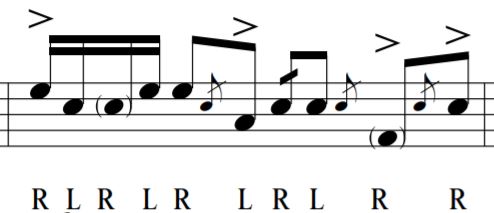
This lick starts off pretty straight forward with 16th and 8th notes with a few flams (measure is in 4/4 time signature). Please note that the “+” of count 2 is a Left Cross on drum 3. Be sure to use your best CROSSES technique, keeping the hands nice and low.
4:3 Trickery
Alright, I hope you have done your homework, because this is where the lick really starts to get tricky. We have two groups of 4:3 which means there are 4 notes over the span of 3 eighth notes.
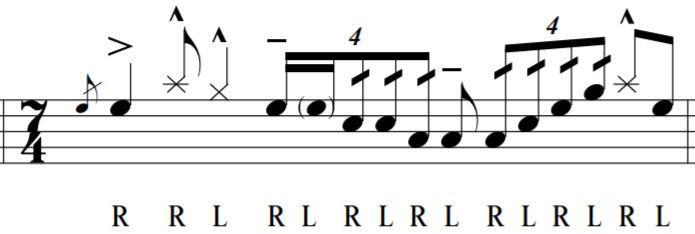
The first grouping starts on the “+” of count 3 and releases on the downbeat of count 5. This release is a nice checkpoint to make sure you are playing the 4:3 at the correct speed. (Pro tip: Turn on the 8th notes on your metronome, so you can also have those reference points as well.)
The check pattern for this first 4:3 is R-R-L-R with a release on the Left. Lock this in first, before playing the part as written. When you master that, make sure that your paradiddle-diddle-diddle has eight evenly spaced notes and releases just as the metronome clicks on count 5.
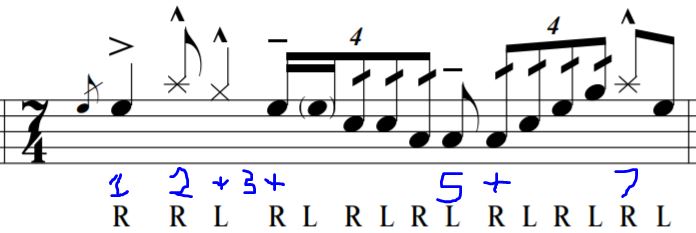
Isolate these five counts on one drum until you can consistently play it perfectly. I have my metronome set to 100 to 110bpm, nice and slow. This way, any timing discrepancy is very obvious. Once you have it locked in, the around pattern isn’t too difficult, just take it one count at a time until you have it in your hands.
We use the same approach for the second 4:3 grouping. This one starts on the “+” of count 5 and releases on the downbeat of count 7. This time, we are playing all doubles, so feel free to remove them, lock in the speed with the check pattern, and then add them back in. Focus on that release hitting right with the click of the metronome.
More 4:3
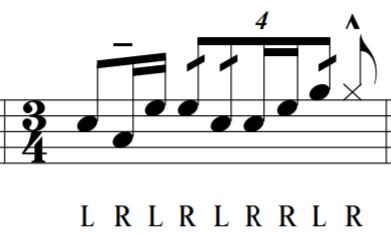
Measure 30 is similar to the previous one. This time, the 4:3 starts on the downbeat of count 2 though, so include the Right release and Right downbeat of the next measure (two Rights in a row) to make sure you have it at the correct speed. Again, we can remove the drags to lock in the speed, and then add them back in.
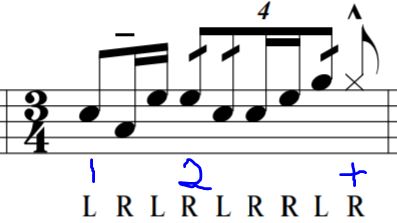
For some reason, the around pattern for this measure was tripping me up. Be sure to bring the Left hand over to drum one on the “a” of count 1 and then over to drum 2 in the 4:3 pattern. As always, approach the sweep from drum 2 to 1 with a nice downward motion to avoid hitting any rims.
Let’s Run this Chunk
Now that we can play through these first few measures, let’s put them together. First, run measures 28-29.

Then, add measure 30. Don’t be afraid to play it all on one drum first before moving it around.

The Most Subtle Change
In measure 31, we have probably the most subtle change in speed that I’ve ever seen! The triplet roll is just the tiniest bit faster than the 4:3, so we are really going to need our interp locked in.
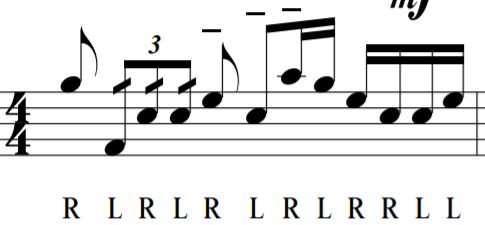
Doing the math, the four notes from 4:3 take up 1.5 counts, but four Triplet notes would only take up 1.33 counts, so they are just ever so slightly faster.
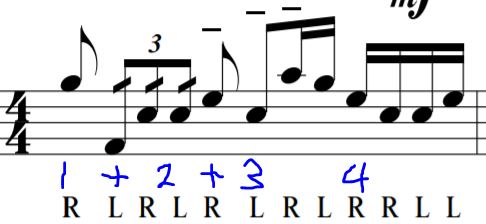
It might throw you off having the triplet roll start on the “+” of count 1. Like we did with the 2000 Cavaliers Tenor Feature, think of the eighth-note clicks of the metronome as quarter notes. That way, the triplet roll starts on count 2. Once you get the feel for it, then you can change back to the regular way of counting through it.
For the voicing, it’s not too bad until we get to the paradiddlediddle at the end. Make sure those inward sweeps are approached with a downward motion. If you come down at an angle (slice), you will most likely hit a rim or two.
Pancakes Anyone?
The rest of the lick gives our brains a break, and we get to have some fun. The inward sweeps from the last measure release with a Right cross on drum 2 (Left hand down on drum 3).
We then do a little “Pancake Spin” (not sure if I just made that up) with our Right hand to bring it over to drum 3. From there we have a paradiddlediddle with a quick Left cross on drum 3, and a Right sweep from drum 2 to 1.
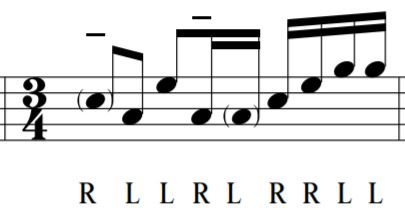
Finish with Fast Singles
We finish out the 2014 Bluecoats Tenor Feature with one of my favorite things to play, super fast singles! These start out on the shot drums and work their way down the drums. We have just one Right cross on drum 2.

Make sure to start low and crescendo all the way down to a rim shot on drum 4. Then, bring both arms up for a huge double-stop release on the bottom drums.
Run the Second Half
Once you can get these last couple measures down individually, piece them together. I suggest starting with the last two measures and slowly add more and more to the beginning, until you are running the whole lick.

Give yourself a high five, you deserve it. BUT, now you have the arduous task of getting it up to 210bpm! For me, it was getting pretty sloppy above 200bpm, so that’s where I maxed out.
Take it slow and only increase the tempo after you can consistently play it perfectly at the slower tempo.
Good luck!
Want to stay in touch? Fill out the form below and never miss a beat!

